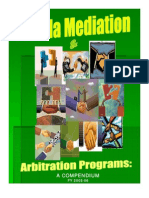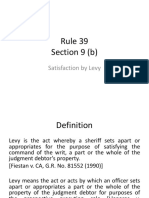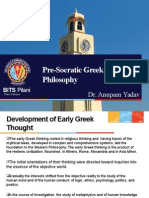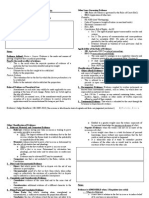Chapter 25
Chapter 25
Uploaded by
abdullaCopyright:
Available Formats
Chapter 25
Chapter 25
Uploaded by
abdullaCopyright
Available Formats
Share this document
Did you find this document useful?
Is this content inappropriate?
Copyright:
Available Formats
Chapter 25
Chapter 25
Uploaded by
abdullaCopyright:
Available Formats
Auditing and Assurance Services
Seventeenth Edition, Global Edition
Chapter 25
Professional Ethics
Copyright © 2020 Pearson Education Ltd. All Rights Reserved.
Learning Objectives (1 of 2)
25.1 Distinguish ethical from unethical behavior in personal
and professional contexts
25.2 Resolve ethical dilemmas using an ethical framework
25.3 Explain the importance of ethical conduct for the
accounting profession
25.4 Describe the purpose and content of the AICPACode
of Professional Conduct
Copyright © 2020 Pearson Education Ltd. All Rights Reserved.
Learning Objectives (2 of 2)
25.5 Apply the AICPACode rules and interpretations on
independence and explain their importance
25.6 Understand the Sarbanes–Oxley Act and other SE C
and PCAO B independence requirements and
additional factors that influence auditor independence
25.7 Understand the requirements of other rules under the
AICPACode
25.8 Describe the enforcement mechanisms for CPA
conduct
Copyright © 2020 Pearson Education Ltd. All Rights Reserved.
What Are Ethics?
• Ethics can be defined broadly as a set of moral principles
or values
• Ethical behavior is necessary for a society to function in
an orderly manner
• The need for ethics in society is sufficiently important that
many commonly held ethical values are incorporated into
laws
Copyright © 2020 Pearson Education Ltd. All Rights Reserved.
Why People Act Unethically
• Most people define unethical behavior as conduct that
differs from what they believe is appropriate given the
circumstances
• There are two primary reasons why people act
unethically:
– The person’s ethical standards are different from those
of society as a whole
– The person chooses to act selfishly
Copyright © 2020 Pearson Education Ltd. All Rights Reserved.
Figure 25.1 Illustrative Prescribed
Ethical Principles
Copyright © 2020 Pearson Education Ltd. All Rights Reserved.
Special Need for Ethical Conduct in
Professions
• Professionals are expected to conduct themselves at a
higher level than most other members of society
• Public confidence in the quality of professional services is
enhanced by high standards of performance and conduct
• It is essential that:
– Client and external financial statement users have
confidence in the quality of audits and other services
– Users regard CPAfirms as competent and unbiased
Copyright © 2020 Pearson Education Ltd. All Rights Reserved.
Difference Between CPA Firms and
Other Professionals
• Other professionals are typically engaged and paid by a
client and have primary responsibility to be an advocate
for that client
• CPA firms are usually engaged by management for
private companies and the audit committee for public
companies:
– They are paid by the company issuing the financial
statements
– The primary beneficiaries of the audit are financial
statement users
Copyright © 2020 Pearson Education Ltd. All Rights Reserved.
Figure 25.2 Ways the Profession and
Society Encourage C P As to Conduct
Themselves at a High Level
Copyright © 2020 Pearson Education Ltd. All Rights Reserved.
Code of Professional Conduct (1 of 2)
• Members of the A I C P A agree to follow the A I C P A Code of
Professional Conduct
• The Code consists of:
– Principles that provide the framework for the rules that
govern the CPA’s performance of professional
responsibilities
– Rules of Conduct that must be followed by members
– Interpretations of the rules to address circumstances
members may face that are threats to compliance with
the rules of conduct
Copyright © 2020 Pearson Education Ltd. All Rights Reserved.
Code of Professional Conduct (2 of 2)
• Rules of conduct are enforceable and many practitioners
refer to them as the A I C P A Code of Professional Conduct
• When practitioners conduct themselves at the minimum
level set up the profession, it does not imply unsatisfactory
conduct
• The profession has presumably set the standards
sufficiently high to make the minimum conduct satisfactory
Copyright © 2020 Pearson Education Ltd. All Rights Reserved.
Table 25.2 Principles of Professional
Conduct (1 of 2)
Principle Description
Responsibilities In carrying out their responsibilities as professionals, members
should exercise sensitive professional and moral judgments
in all their activities.
The Public Interest Members should accept the obligation to act in a way that will
serve the public interest, honor the public trust, and
demonstrate a commitment to professionalism.
Integrity To maintain and broaden public confidence, members should
perform all professional responsibilities with the highest
sense of integrity.
Copyright © 2020 Pearson Education Ltd. All Rights Reserved.
Table 25.2 Principles of Professional
Conduct (2 of 2)
Principle Description
Objectivity and A member should maintain objectivity and be free of conflicts of
Independence interest in discharging professional responsibilities. A
member in public practice should be independent in fact and
appearance when providing auditing and other attestation
services.
Due Care A member should observe the profession’s technical and
ethical standards, strive continually to improve competence
and quality of services, and discharge professional
responsibility to the best of the member’s ability.
Scope and Nature A member in public practice should observe the principles of
of Services the Code of Professional Conduct in determining the scope
and nature of services to be provided.
© 2017, AI C PA. All rights reserved. Used by permission.
Copyright © 2020 Pearson Education Ltd. All Rights Reserved.
Table 25.3 Threats to Compliance with
Rules Under the A I C P A Code of
Professional Conduct (1 of 3)
Threat Definition Example of a Threat
Adverse The threat that a member will not act with An officer, director, or significant
interest objectivity because the member’s interests shareholder participates in
are opposed to the attest client’s interests. litigation against the firm.
Advocacy The threat that a member will promote an A member endorses an attest
attest client’s interest or position to the point client’s services or products.
that his or her objectivity or independence
is compromised.
Familiarity The threat that, due to a long or close A member’s close friend is
relationship with an attest client, a member employed by the client.
will become too sympathetic to the client’s
Interest or too accepting of the client’s work
or product.
Copyright © 2020 Pearson Education Ltd. All Rights Reserved.
Table 25.3 Threats to Compliance with
Rules Under the A I C P A Code of
Professional Conduct (2 of 3)
Threat Definition Example of a Threat
Management The threat that a member will take on the role Due to a loss of client personnel,
Participation of an attest client management or otherwise the attest client asks a member
assume management responsibilities, such firm to assist with accounting
as may occur during an engagement to activities, including the
provide nonattest services. authorization of transactions.
Self-interest The threat that a member could benefit, The member has a financial
financially or otherwise, from an interest in, interest in an attest client, and
or relationship with, an attest client or the outcome of a professional
persons associated with the client. services engagement may
affect the fair value of the
financial interest.
Copyright © 2020 Pearson Education Ltd. All Rights Reserved.
Table 25.3 Threats to Compliance with
Rules Under the A I C P A Code of
Professional Conduct (3 of 3)
Threat Definition Example of a Threat
Self-review The threat that a member will not The member performs
appropriately evaluate the results of a bookkeeping services for the
previous judgment or service performed or attest client and then performs
supervised by the member or an individual an audit of those financial
in the member’s firm and that the member statements.
will rely on that service in forming a
judgment as part of another service.
Undue The threat that a member will subordinate his The client indicates that it will not
influence or her judgment to an individual associated award additional engagements
with a client or any relevant third party due to the firm if the firm continues
to that individual’s reputation or expertise, to disagree with the client on
aggressive or dominant personality, or an accounting or tax matter.
attempts to coerce or exercise excessive
influence over the member.
© 2017, AI C PA. All rights reserved. Used by permission.
Copyright © 2020 Pearson Education Ltd. All Rights Reserved.
Figure 25.3 Standards of Conduct
Copyright © 2020 Pearson Education Ltd. All Rights Reserved.
Independence Rule (1 of 3)
• The value of auditing depends heavily on the public’s
perception of the independence of auditors
• CPA firms are required to be independent for certain
services that they provide:
– The Independence Rule applies to audits and other
types of attestations
– A CPA firm can do tax returns and provide
management services without being independent
Copyright © 2020 Pearson Education Ltd. All Rights Reserved.
Independence Rule (2 of 3)
• Independence consists of two components:
– Independence of mind
Reflects the auditor’s state of mind that permits the
audit to be performed with an unbiased attitude
– Independence in appearance
The result of others’ interpretations of the auditor’s
independence
Copyright © 2020 Pearson Education Ltd. All Rights Reserved.
Independence Rule (3 of 3)
• Significant issues and interpretations involving
independence:
– Financial interests
– Related financial interest issues
– Consulting, bookkeeping, and other nonattest services
– Litigation between CPA firm and client
– Unpaid fees
– Network of firms
Copyright © 2020 Pearson Education Ltd. All Rights Reserved.
Copyright © 2020 Pearson Education Ltd. All Rights Reserved.
Learning Objective 25.6
Understand the Sarbanes–Oxley Act and other SEC and
PCAOB independence requirements and additional factors
that influence auditor independence
Copyright © 2020 Pearson Education Ltd. All Rights Reserved.
Sarbanes–Oxley and Related
Independence Requirements (1 of 2)
• Auditors of public companies must comply with the
independence requirements of the Sarbanes–Oxley Act,
the PCAOB, and the SEC
• Sarbanes–Oxley and SEC rules restrict the types of
nonaudit services that can be provided to publicly held
audit clients
• Sarbanes–Oxley also requires the audit committee of a
public company to be responsible for the appointment,
compensation, and oversight of the work of the auditor
Copyright © 2020 Pearson Education Ltd. All Rights Reserved.
Copyright © 2020 Pearson Education Ltd. All Rights Reserved.
Sarbanes–Oxley and Related
Independence Requirements (2 of 2)
• There are other independence rules related to the
following:
– Conflicts arising from employment relationships
– Partner rotation
– Ownership interests
– Shopping for accounting principles (“opinion
shopping”)
– Engagement and payment of audit fees by
management
Copyright © 2020 Pearson Education Ltd. All Rights Reserved.
Cancelled Parts
Objective 2: Ethical Dilemmas
Objective 7: Other Rules of Conduct
Objective 8: Enforcement
Pages
788 - 791
805 - 814
Copyright © 2020 Pearson Education Ltd. All Rights Reserved.
You might also like
- DEED OF ABSOLUTE SALE OF A Water StationDocument3 pagesDEED OF ABSOLUTE SALE OF A Water StationAngie Douglas77% (35)
- Test Bank For Auditing A Practical Approach 3rd Canadian Edition by Robyn MoroneyDocument35 pagesTest Bank For Auditing A Practical Approach 3rd Canadian Edition by Robyn MoroneyNitin100% (1)
- Chapter 3Document48 pagesChapter 3Anh Vu100% (1)
- Project 3: Personal Business Plan: Learning Outcome AddressedDocument3 pagesProject 3: Personal Business Plan: Learning Outcome AddressedAnjali MishraNo ratings yet
- GAMSAT Practice EssayDocument2 pagesGAMSAT Practice EssayHaseeb RayhanNo ratings yet
- RWS 2.4 Sentence OutlineDocument13 pagesRWS 2.4 Sentence OutlineMargie T. Javier50% (4)
- Ame - Book Abstracts VF 05.11.18 PDFDocument492 pagesAme - Book Abstracts VF 05.11.18 PDFMayara Lima0% (1)
- Arens Aas17 PPT 25Document45 pagesArens Aas17 PPT 25Loo Bee YeokNo ratings yet
- Chapter 15 EthicsDocument29 pagesChapter 15 Ethicsu2104145No ratings yet
- Chapter-Two: Professional Ethics and Legal Responsibilities & Liabilities of AuditorsDocument46 pagesChapter-Two: Professional Ethics and Legal Responsibilities & Liabilities of AuditorsKumera Dinkisa ToleraNo ratings yet
- Ethic Audit 2 2023Document36 pagesEthic Audit 2 2023Agus HybanaNo ratings yet
- Slides - Lecture 2 - ST VersionDocument17 pagesSlides - Lecture 2 - ST VersionNguyễn Thu UyênNo ratings yet
- Audit I-Chapter TwoDocument11 pagesAudit I-Chapter Twothedalesh weldeNo ratings yet
- AuditingDocument12 pagesAuditingMY GODNo ratings yet
- Chapter 3Document56 pagesChapter 3Michael AnthonyNo ratings yet
- Document1Document12 pagesDocument1lojuju79No ratings yet
- A$a L2 EditedDocument6 pagesA$a L2 EditedKimosop Isaac KipngetichNo ratings yet
- At.1304 - Code of EthicsDocument29 pagesAt.1304 - Code of EthicsSheila Mae PlanciaNo ratings yet
- ACCY342 Tutorial Solutions (CHP 2) s1 2014Document5 pagesACCY342 Tutorial Solutions (CHP 2) s1 2014Bella SeahNo ratings yet
- ACCA AA Chapter 2 Study GuideDocument20 pagesACCA AA Chapter 2 Study GuideNUR AIN MOHD NAHARNo ratings yet
- Introduction To Independence and GIP - Jan 2011Document16 pagesIntroduction To Independence and GIP - Jan 2011Praveen MalineniNo ratings yet
- Chapter 15 EthicsDocument49 pagesChapter 15 EthicsDinda syafiraNo ratings yet
- Advanced AuditingDocument76 pagesAdvanced AuditingShumail AkhundNo ratings yet
- Lecturer 2 (Ii) - Professional EthicsDocument41 pagesLecturer 2 (Ii) - Professional EthicskhooNo ratings yet
- Audit-Professional EthicsDocument5 pagesAudit-Professional EthicsRhn Habib RehmanNo ratings yet
- Day 5 Inter 24 BookDocument5 pagesDay 5 Inter 24 Bookap.quatrroNo ratings yet
- Code of EthicsDocument24 pagesCode of EthicsEman SaeedNo ratings yet
- Code of EthicsDocument22 pagesCode of EthicsMamunoor RashidNo ratings yet
- 2014december14codeofprofessionalconduct PDFDocument227 pages2014december14codeofprofessionalconduct PDFBeomiNo ratings yet
- EtDocument18 pagesEtaceNo ratings yet
- Code of Professional EthicsDocument42 pagesCode of Professional EthicsMariella CatacutanNo ratings yet
- Code of Ethics: For Professional AccountantsDocument130 pagesCode of Ethics: For Professional AccountantsSalvador BrionesNo ratings yet
- Audit and Assuarance - To Present - C4Document77 pagesAudit and Assuarance - To Present - C4HaziNo ratings yet
- Rules of Conduct-En-2021Document11 pagesRules of Conduct-En-2021Kota BalaNo ratings yet
- The Code of Ethics For Cpas in The Philippines: Chapter SixDocument24 pagesThe Code of Ethics For Cpas in The Philippines: Chapter SixQueenie QuisidoNo ratings yet
- IBAZ Code of Professional ConductDocument26 pagesIBAZ Code of Professional ConductTakunda RusereNo ratings yet
- Code of Ethics 5th Year Acc. ReviewDocument10 pagesCode of Ethics 5th Year Acc. ReviewCykee Hanna Quizo LumongsodNo ratings yet
- Code of Etichs of Professional AccountantsDocument40 pagesCode of Etichs of Professional AccountantsYamateNo ratings yet
- BKAA 3023 Â " Topic 1 - Code of Ethics For AuditorsDocument20 pagesBKAA 3023 Â " Topic 1 - Code of Ethics For AuditorsDarren 雷丰威No ratings yet
- Cpa Aud Su1 CC MergedDocument59 pagesCpa Aud Su1 CC MergedPriyanka RawatNo ratings yet
- Resume Pengauditan Chapter 4Document4 pagesResume Pengauditan Chapter 4Mulia PutriNo ratings yet
- ABS-LECTURE 3 (Professional Ethics)Document32 pagesABS-LECTURE 3 (Professional Ethics)Lordwin ArcherNo ratings yet
- Chapter 4Document5 pagesChapter 4alansiju010No ratings yet
- Chapter 2Document21 pagesChapter 2Danish NabilNo ratings yet
- Code of Ethics For AccountantsDocument49 pagesCode of Ethics For AccountantsAlly CapacioNo ratings yet
- Auditing Ethics: Lecture # 2 Fundamental PrinciplesDocument3 pagesAuditing Ethics: Lecture # 2 Fundamental PrinciplessiddiqueicmaNo ratings yet
- 3 Files MergedDocument76 pages3 Files MergedIrakli OsadzeNo ratings yet
- AT 02.03 - AT 02.07: Code of Ethics For Professional AccountantsDocument8 pagesAT 02.03 - AT 02.07: Code of Ethics For Professional AccountantscasmortelleNo ratings yet
- Code of Ethics For Professional Accountants in The PhilippinesDocument97 pagesCode of Ethics For Professional Accountants in The PhilippinesBooks and StuffsNo ratings yet
- Code of Ethics - EditedDocument76 pagesCode of Ethics - EditedAaron Mañacap100% (1)
- R56 Ethics and Trust in The Investment Profession IFT NotesDocument16 pagesR56 Ethics and Trust in The Investment Profession IFT NotesMD.HOSSNEE JAMILNo ratings yet
- UNIT 2 Professional Ethics of AuditorsDocument4 pagesUNIT 2 Professional Ethics of AuditorsKhalid Muhammad100% (1)
- Lesson 4 Code of Ethics - 20240708 - 092502 - 0000Document11 pagesLesson 4 Code of Ethics - 20240708 - 092502 - 0000kayanajao133No ratings yet
- Chap. 6 Code of Ethics For CPAsDocument105 pagesChap. 6 Code of Ethics For CPAsMichaella ManlapazNo ratings yet
- Modern Auditing 7th Edition Modern Auditing 7th EditionDocument15 pagesModern Auditing 7th Edition Modern Auditing 7th Editionastoeti_sriNo ratings yet
- Code of EthicsDocument33 pagesCode of EthicsIcah Mae D. SaloNo ratings yet
- Chapter 1Document19 pagesChapter 1ReshmajitKaurNo ratings yet
- 4 Quality ControlDocument10 pages4 Quality ControlMoffat MakambaNo ratings yet
- Business Ethics Governance Risk AssignmentDocument5 pagesBusiness Ethics Governance Risk AssignmentMahak KulshresthaNo ratings yet
- 3 Auditor Independence & Audit Quality SVDocument54 pages3 Auditor Independence & Audit Quality SVSiham OsmanNo ratings yet
- True or FalseDocument5 pagesTrue or Falseyaphets0116No ratings yet
- Students - Topic 2 Ethics and Safeguards Week 4-8Document7 pagesStudents - Topic 2 Ethics and Safeguards Week 4-8Azim AnodNo ratings yet
- R2 Code of Ethics and Standards of Professional ConductDocument4 pagesR2 Code of Ethics and Standards of Professional Conductdar shilNo ratings yet
- Member Ethical StandardsDocument9 pagesMember Ethical StandardsEDWIN YEBRAIL BERNAL SANCHEZNo ratings yet
- Annexure A Study On Quality of Work Life Balance of The Employee in J.Q Trye Manufacturing Industry at CoimbatoreDocument5 pagesAnnexure A Study On Quality of Work Life Balance of The Employee in J.Q Trye Manufacturing Industry at Coimbatorek eswariNo ratings yet
- The Art of Strategic Management-A Key To Success in Corporate SectorDocument4 pagesThe Art of Strategic Management-A Key To Success in Corporate SectorSubhan AliNo ratings yet
- Training Needs ResearchDocument12 pagesTraining Needs ResearchCharisa SamsonNo ratings yet
- MEDIATION FLORIDA 2005-06 Compendium Final Draft-With Improved MapDocument110 pagesMEDIATION FLORIDA 2005-06 Compendium Final Draft-With Improved MapBANKUNITED_FRAUDNo ratings yet
- Toman Családi KonstellációDocument4 pagesToman Családi Konstellációlole85No ratings yet
- Horner I B TR Book of The Discipline Vinaya Pitaka Vol III Suttavibhanga 512pDocument512 pagesHorner I B TR Book of The Discipline Vinaya Pitaka Vol III Suttavibhanga 512ptrungdaongoNo ratings yet
- Coping With Case Studies - The 5P'sDocument5 pagesCoping With Case Studies - The 5P'sGideon M KimariNo ratings yet
- Name: ID: Program: Assignment No: Code: Semester:: Developing Research ReportsDocument28 pagesName: ID: Program: Assignment No: Code: Semester:: Developing Research ReportsIftikhar AhmadNo ratings yet
- JESA-plumbing Works Rev. BDocument15 pagesJESA-plumbing Works Rev. BLeo PascualNo ratings yet
- BÀI TẬP LEXICO - WORDFORM - CLOZE TESTDocument170 pagesBÀI TẬP LEXICO - WORDFORM - CLOZE TESTTrang Lê100% (2)
- Rule 39 Section 9 (B) : Satisfaction by LevyDocument8 pagesRule 39 Section 9 (B) : Satisfaction by LevyLeo Balante Escalante Jr.No ratings yet
- 1966 41Document147 pages1966 41ShipaNo ratings yet
- Philippine Standards On Quality Control (PSQC) (PSQC1, PSA 220)Document17 pagesPhilippine Standards On Quality Control (PSQC) (PSQC1, PSA 220)Mary Grace Dela CruzNo ratings yet
- Autistic Self Advocacy Network Webinar With Autism NOW July 29 2014Document28 pagesAutistic Self Advocacy Network Webinar With Autism NOW July 29 2014The Autism NOW CenterNo ratings yet
- Ob - Unit 3 Reference Notes - Group DynamicsDocument34 pagesOb - Unit 3 Reference Notes - Group DynamicsAnkit sharmaNo ratings yet
- Pre-Socratic Greek PhilosophyDocument11 pagesPre-Socratic Greek PhilosophyAdil Islam100% (1)
- Rubino Anna Phil 161 Paper 2Document5 pagesRubino Anna Phil 161 Paper 2api-701459983No ratings yet
- Social Justice Society V Dangerous Drugs Board DIGESTDocument3 pagesSocial Justice Society V Dangerous Drugs Board DIGESTCROCS Acctg & Audit Dep'tNo ratings yet
- Verity - Colleen Hoover (1)Document13 pagesVerity - Colleen Hoover (1)Gianna ChinettiNo ratings yet
- Is AI Recruiting (Un) Ethical? A Human Rights Perspective On The Use of AI For HiringDocument15 pagesIs AI Recruiting (Un) Ethical? A Human Rights Perspective On The Use of AI For HiringMihiraka alahakoonNo ratings yet
- Catching BeliefDocument3 pagesCatching BeliefAliosha BielenbergNo ratings yet
- 02 Revista Universul Juridic NR 10-2015 PAGINAT BT GH DobricanDocument15 pages02 Revista Universul Juridic NR 10-2015 PAGINAT BT GH Dobricanoshizara zamatachi dodomuraNo ratings yet
- Worksheet No. 3: Work ImmersionDocument4 pagesWorksheet No. 3: Work ImmersionDhana Mitzy A. MacaranasNo ratings yet
- Plato's Republic (Final)Document3 pagesPlato's Republic (Final)IleenMae100% (1)
- Examples:: Evidence - Judge Bonifacio - 3B 2009-2010 1Document72 pagesExamples:: Evidence - Judge Bonifacio - 3B 2009-2010 1Monaliza BanaNo ratings yet

























































































